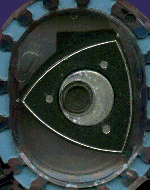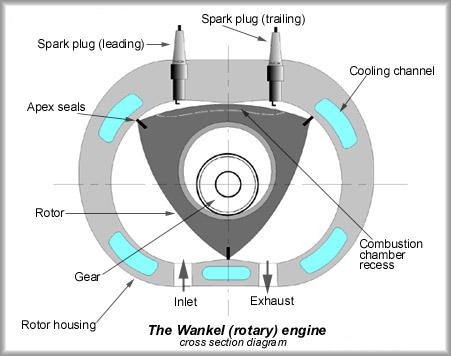|

|
| The inside of a Wankel Rotary engine |

|
A Brief History: You could almost say the Rotary is a "new technology" internal combustion engine. Dr Felix Wankel, born in South Germany an engineer invented and patented the Rotary device in 1933. There is a large history behind the Rotary engine, including one of the first designs having both the rotor and rotor housing rotate, this was shelved, due to being to complex to manufacture, for the simpler design very much like the current day rotary made by Mazda in the RX series of vehicles. By the way NSU made a car with a rotary engine, the NSU Ro80. What does the rotary do so well? For a start the rotary feels like a turbine device more so than a conventional piston engine. It's easy to see why, the rotor is carried in orbit around the output shaft, and rotates inside the rotor housing it's self, thus creating less vibration like movement than in a piston engine, and the faster a rotary revs the smoother it seems. Rotaries tend to be very strong at high RPM, and have been described as unbreakable, although this is not the case, but they are strong and handle high revs well. Rotaries have an excellent power output per size of the engine. A Mazda RX-7 for example has a 13b, very small in capacity and physical size but producing the power of a six cylinder. All this allows the car to also be smaller and lighter. The rotary engine has very few moving parts making them easy to maintain and reliable. Rotaries have excellent throttle response. What does the rotary not do so well! The rotary engine has more oil consumption than a conventional piston engine. The reason for this is a certain amount of oil is fed into the combustion chamber to lubricate the apex seals. Rotaries also use a little more fuel than piston engines, and are not regarded as economical, although in the applications Mazda use the rotary (sports cars) fuel consumption is not a large issue. Although the sound of a rotary is not bad, they are louder generally. A lot of people say rotaries wear out quicker than piston engines, but this is not the case in reality. Who uses rotaries? Mazda is the only mainstream car manufacturer using the rotary, in the awesome RX7. NASA also use rotaries on the space shuttle as pumps, they use the rotary because it is very smooth running. Some aircraft have had rotaries put in them, but don't confuse a rotary with a "ROTAX", this is something different that is used in ultra light aircraft. How does it work? Both conventional piston engines and rotaries produce power through the expansion of combusted gasses, after the mixture of fuel and air are ignited. Piston engines use the expansion of gasses to force the piston down to then turn the crankshaft. Rotaries use the expansion of gasses directed at the rotor flank, directional to the center of eccentricity resulting in rotating the rotor which then turns the eccentric shaft to produce power to the drivetrain. The rotor moves around in a planetary motion, the three apices are always in contact with the rotor housing and the apex seals keep each of the three combustion chambers sealed. The 3 lobe rotor creates 3 separate chambers inside a 2 lobe trochoid chamber. The rotary engine is a four stroke cycle, each completed in a chamber in succession during a single rotation. Although this section has described the basic workings, there is a lot more involved in the whole process, including things like fuel delivery (now days fuel injection, and turbo) and ignition systems. The rotary made by Mazda has two ignition systems, one for the trailing spark plug and another for the leading spark plug, both timed to fire at a precise time one after another. The diagram below is a simple cross section showing the main basic components of the rotary engine. There are many books on the subject worth having a look at. |

| Last Updated 22/04/99 |
| Contact blake roeleven at : [email protected] |